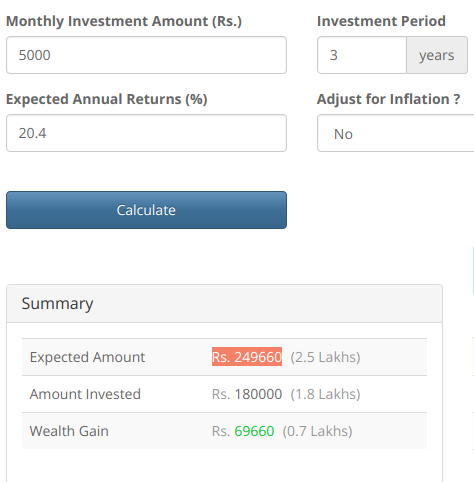I couldn't see the fund in your screenshot, but here is the one from the web link.

The one-year return can be calculated like so.

Also using a formula
a = d ((1 + r)^n - 1)/r
where
a is the future amount
d is the monthly payment (paid at month-end)
n is the number of months
r is the monthly interest rate
The annual interest rate is 14.4%
r = (1 + 14.4/100)^(1/12) - 1 = 0.011274
n = 12
d = 5000
a = d ((1 + r)^n - 1)/r = 63863.84
The same in Excel

The 3 year result is a little out, presumably some rounding inaccuracy
r = (1 + 19.3/100)^(1/12) - 1 = 0.0148146
n = 36
d = 5000
a = d ((1 + r)^n - 1)/r = 235556.95
A 3 year annualised return of 19.26% obtains the website figure, shown below.
r = (1 + 19.26/100)^(1/12) - 1 = 0.0147862
n = 36
d = 5000
a = d ((1 + r)^n - 1)/r = 235431.40
I would guess the interest rate in the calculations is 19.26% but the website shows the figure rounded to one decimal place, as 19.3%.









=FV((1+20.41/100)^(1/12)-1,36,-5000)produces 239059. All explained in my answer.=FV(20.4/100/12,36,-5000,0,1)producing 249660. The main differences are that the interest rate here is nominal compounded monthly rather than effective annual rate, and the payments are at month-start rather than month-end. Presumably the Mirae calculator uses month-end payments because the lump sum calculates from month-start and they don't want a SIP payment at the same time as the lump sum, but it means the last SIP payment accrues no interest.=FV((1+20.4/100)^(1/12)-1,36,-5000,0,1)producing 242754.